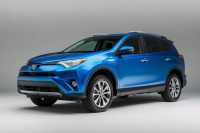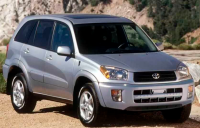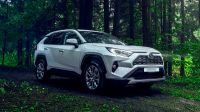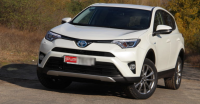Today's review will focus on two long-standing rivals that have been breathing down each other's necks: first one, then the other. If you were asked which crossover is better: the Toyota Rav 4 or the Nissan X-Trail, what would you say?
Surely, if you're quite familiar with each model, you'd say: 'Depending on the year'. Indeed, when discussing the model ranges of both brands prior to 2012, the Rav4 was the clear favourite. However, with the release of the new generation, everything went the other way round - the X-Trail took the lead in almost all respects. This was true of design, optional equipment, comfort and even dynamics. Nissan rogue vs. Toyota rav4 would be next review
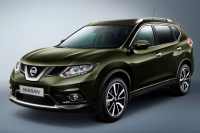 The breakthrough was due to the constant lagging behind Toyota over the years, and the developers, tired of perpetual 'second place', turned the new model from catching up to leading the way. But that was, as we've already discussed, back in 2012. By 2016, both companies released restyled versions of their crossovers. Toyota tried to work on its mistakes and implement all its refinements, while Nissan intended to consolidate its once-occupied leadership position. Who will turn out to be the favourite now? Let's take a look.
The breakthrough was due to the constant lagging behind Toyota over the years, and the developers, tired of perpetual 'second place', turned the new model from catching up to leading the way. But that was, as we've already discussed, back in 2012. By 2016, both companies released restyled versions of their crossovers. Toyota tried to work on its mistakes and implement all its refinements, while Nissan intended to consolidate its once-occupied leadership position. Who will turn out to be the favourite now? Let's take a look.
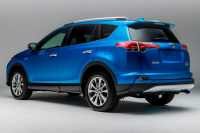
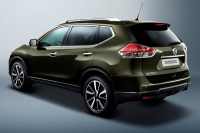 Appearance
Appearance
The new body of the Rav 4, launched in 2012, was instantly criticised for its "femininity". Indeed, not a trace of its former brutality remains. The car's appearance seems to have been more suited to the fairer half of humanity. In contrast, the exterior of the X-Trail was received with admiration. Aggressive "look" of the new LED lights, massive V-shaped inset on the front grille, slightly blowing rounded silhouette - all these elements together created the image of an adult, strong, solid, but at the same time modern crossover. Designers managed to combine courage and technology in one body. At the same time, it didn't seem "chopped" and didn't suffer from a "complex" of straight lines, unlike its classmate.
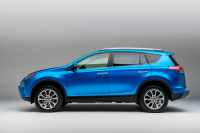
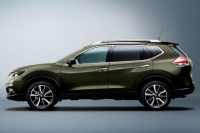 Four years on, the changes to the bodywork on Nissan's part are not particularly noticeable. They are certainly present, but they don't significantly affect the crossover's image, changing it much, unlike the pre-styled version. Toyota's outlook is more positive. Like we said, they've done some work on the bugs. New, now like its rival, LED headlights, extra curves in the bonnet and radiator grille add to the aggressiveness. The design of the front end has been seriously redesigned. The front end began to look prettier. But in opinion of many people the sensation of femininity is still there. Probably this is an aftertaste from the 2012 body and the buyers just need a time to get used to it. Anyway, for a domestic market this factor is a plus to some extent as more and more women are transplanted from small-capacity models to big crossovers
Four years on, the changes to the bodywork on Nissan's part are not particularly noticeable. They are certainly present, but they don't significantly affect the crossover's image, changing it much, unlike the pre-styled version. Toyota's outlook is more positive. Like we said, they've done some work on the bugs. New, now like its rival, LED headlights, extra curves in the bonnet and radiator grille add to the aggressiveness. The design of the front end has been seriously redesigned. The front end began to look prettier. But in opinion of many people the sensation of femininity is still there. Probably this is an aftertaste from the 2012 body and the buyers just need a time to get used to it. Anyway, for a domestic market this factor is a plus to some extent as more and more women are transplanted from small-capacity models to big crossovers
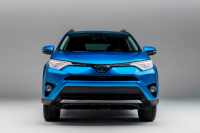
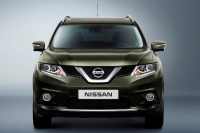 To summarise the first part of the review, the most attractive design, which will find its connoisseurs among both men and women, is that of the Nissan. The competitor isn't far behind, though.
To summarise the first part of the review, the most attractive design, which will find its connoisseurs among both men and women, is that of the Nissan. The competitor isn't far behind, though.
Interior and options
Comparing 2012 models, the X-Trail was clearly the winner in terms of these features, but four years later the rival has pulled up. At the moment, both brands have equal dashboards in terms of ergonomics. "Torpedo" Toyota at first glance seems more modern and technically equipped. The cars' temperament, which can be traced on the outside, is transferred on the inside.
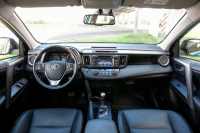
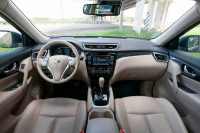 Nissan's interior has rounded, flowing lines, giving the impression of cosiness and lightness. Toyota's is more angular. The disadvantage in both saloons is the inaccessibility of certain buttons. Buttons for heating of seats in the first one are on the central armrest that offers to distract the driver from the road for adjustment of these parameters. But in Rav4 these same buttons can be found at the bottom of the central part of a dashboard. And they are located in such a way, that one should bend down for reviewing of keys' position and their right pressing, and it doesn't make for safe driving. Objectively speaking, Nissan's dashboard is more comfortable and ergonomic, although again the advantage is not great.
Nissan's interior has rounded, flowing lines, giving the impression of cosiness and lightness. Toyota's is more angular. The disadvantage in both saloons is the inaccessibility of certain buttons. Buttons for heating of seats in the first one are on the central armrest that offers to distract the driver from the road for adjustment of these parameters. But in Rav4 these same buttons can be found at the bottom of the central part of a dashboard. And they are located in such a way, that one should bend down for reviewing of keys' position and their right pressing, and it doesn't make for safe driving. Objectively speaking, Nissan's dashboard is more comfortable and ergonomic, although again the advantage is not great.
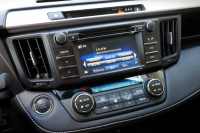
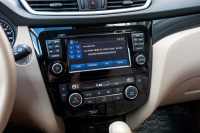 In respect of interior finishing materials, one can give equal pluses in fatness, though the Rav4 will have this mark strained. Leather inside looks very beautiful and is pleasant to the touch. But the rigid plastic which looks cheap and is inharmonious with leather spoils everything. But such subtleties are for a lover.
In respect of interior finishing materials, one can give equal pluses in fatness, though the Rav4 will have this mark strained. Leather inside looks very beautiful and is pleasant to the touch. But the rigid plastic which looks cheap and is inharmonious with leather spoils everything. But such subtleties are for a lover.
Electronic functionality of both models is at a level: heating of seats, parktronic, availability of cameras. It is noteworthy that the 2012 X-Trail had an obvious advantage - all-round visibility. Due to the cameras around the perimeter of the body, the system gave an image to the display as a whole picture, "gluing" fragments. The screen showed the car from above, and the driver could see the movement of all the objects around the car. Initially the Rafiki did not have this option, but in the model under consideration it became available in more expensive variants. Competition is the engine of progress!
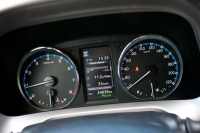
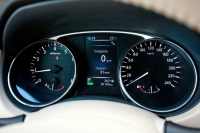 The Rav 4's dashboard and numerals look brighter and larger, which will undoubtedly be appreciated by visually impaired users. In Nissan's favour is the convenient location of the four-wheel-drive system switch. It's a rotatable 'puck' and sits on the centre armrest under the driver's arm. It can be used to easily adjust the suspension modes, of which there are three in the crossover:
The Rav 4's dashboard and numerals look brighter and larger, which will undoubtedly be appreciated by visually impaired users. In Nissan's favour is the convenient location of the four-wheel-drive system switch. It's a rotatable 'puck' and sits on the centre armrest under the driver's arm. It can be used to easily adjust the suspension modes, of which there are three in the crossover:
Front-wheel drive mode;
Automatic front-wheel drive with possible connection of the rear wheels (if the situation requires it);
Positive all-wheel drive mode.
To carry out the same manipulations in the competitor, it is necessary to penetrate into a set of buttons and to remember their correct sequence of pressing. Quite inconvenient.
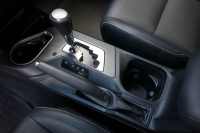
 The X-Trail features dual-zone climate control, which the rival doesn't have. The Rav 4, on the other hand, parries the loss of its classmate by having heated rear seats, with which the above function loses its application. To each opponent on a point.
The X-Trail features dual-zone climate control, which the rival doesn't have. The Rav 4, on the other hand, parries the loss of its classmate by having heated rear seats, with which the above function loses its application. To each opponent on a point.
Noise insulation is also about the same in both cars. The Rav 4 range that rolled off the assembly line in 2012 was heavily criticised for this indicator. But the current model has corrected the inaccuracies of its little brother.

 In terms of passenger space and seating comfort, everything is also about the same. Both the first and second rows of seats have ample space. The only difference is the lateral stability in the front seats. It's slightly better in the Nissan. Though considering the represented class of cars, this indicator is not essential. We are not talking about sports cars. Rear seats in X-Trail are moved back, creating additional space for passengers' legs, but such luxury appears to the detriment of a boot volume. By the way, Toyota has an obvious advantage concerning luggage capacity: 577 litres against 497. Both brands fold down the backs of the rear seats, providing more space, but Nissan does not save it. Toyota continues to lead the way: 1,605l vs 1,585l. If you prioritise boot space for fishing or hunting gear, as well as a tent or suitcases, choose the Rav 4.
In terms of passenger space and seating comfort, everything is also about the same. Both the first and second rows of seats have ample space. The only difference is the lateral stability in the front seats. It's slightly better in the Nissan. Though considering the represented class of cars, this indicator is not essential. We are not talking about sports cars. Rear seats in X-Trail are moved back, creating additional space for passengers' legs, but such luxury appears to the detriment of a boot volume. By the way, Toyota has an obvious advantage concerning luggage capacity: 577 litres against 497. Both brands fold down the backs of the rear seats, providing more space, but Nissan does not save it. Toyota continues to lead the way: 1,605l vs 1,585l. If you prioritise boot space for fishing or hunting gear, as well as a tent or suitcases, choose the Rav 4.
Engine and transmission
The Toyota Rav 4 is currently available with three engine types:
146bhp 2.0-litre petrol;
Gasoline 2.5 litre with 180 bhp;
Turbo-diesel 2.2 liters with 150 hp.
In the same classmate the layout is about the same:
Petrol 2.0 litre, 144bhp;
Petrol 2.5 litre with 171 bhp;
Diesel 1.6 litre, 130 bhp.
As you can see, the motors of the same type in Toyota give out an order of magnitude more horses than in the opponent. It can't help influencing speed indicators. Acceleration from 0 to a hundred at Rafiki is faster by a second, and the car feels more dynamical. But, as the old proverb says: you have to pay for everything in this life. Also the question is not only about a cost, though we shall get to it by all means. Drivers of SUV will have to pay for more pleasant acceleration with higher fuel consumption. If Nissan in the mixed cycle is capable to consume 7-8 litres per one hundred, it is a serious task for its opponent. And if you have accidentally switched on a mode "sports", you can't count on less than 11 litres.
One of the fattest pluses in Rav 4 is presence of automatic transmission that the rival does not have. Nissan offers only 6-speed mechanics, and both models are equipped with a variator.
Driveability
If you've driven the 2012 Rav 4, forget everything you felt. As we've said, Toyota has done a tremendous amount of work on the bugs, and it's not just about aesthetics, but also technology. The handling of the 2016 model is very pleasing - a worthy competitor to its Japanese peer. But it is necessary to notice that despite of approximately identical behaviour on road, the driver gets absolutely different sensations behind a steering wheel.
Smooth measured driving does not cause differences in both cars. True, the accelerator pedal in X-Trail is more responsive than in Rav 4. The engine in combination with the continuously variable variator runs confidently and picks up a smooth but swift acceleration. On slippery surfaces, the rear wheels engage after a certain delay, but this is not too conspicuous.
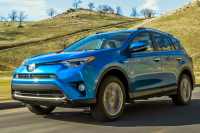
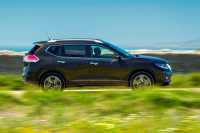 In contrast, its counterpart is almost devoid of slippage when driving smoothly. The all-wheel-drive system is set up like clockwork - the wheels are engaged clearly and on time. However, the accelerator pedal here has big value of "dead zone". It reacts slowly, as if hinting to the driver not to forget about safety. But things can change dramatically when you switch to sport mode. Acceleration becomes just as lively as its rival.
In contrast, its counterpart is almost devoid of slippage when driving smoothly. The all-wheel-drive system is set up like clockwork - the wheels are engaged clearly and on time. However, the accelerator pedal here has big value of "dead zone". It reacts slowly, as if hinting to the driver not to forget about safety. But things can change dramatically when you switch to sport mode. Acceleration becomes just as lively as its rival.
Both competitors respond well to steering movements, although the Toyota has a slight advantage. Both have similar braking and cornering performance. But, as you'll recall, we looked at them during a quiet ride. What kind of beasts will burst out from under the rivals' bonnets when the throttle is sharply pressed and the cornering is abruptly thrown?
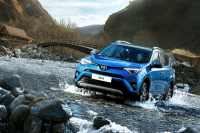
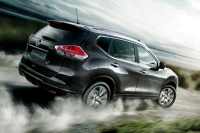 There's a huge difference in feel on the fast lanes. Let's take the Toyota for a spin first. Driving at the car's limit is accompanied by adrenaline, spark, ardor, rapid heartbeat and dilated pupils, but not in this crossover. Rav4 confidently passes turns, on which it behaves calmly and at times even phlegmatically. Yes, the car is steady and reliable, but you will not feel pleasure. It lacks life. It concerns not only the crossover - as a rule, all latest models of the brand possess an excessive share of calmness. But if marketers and engineers have put an emphasis on safety, then everything is in the plus. And it's up to you to choose.
There's a huge difference in feel on the fast lanes. Let's take the Toyota for a spin first. Driving at the car's limit is accompanied by adrenaline, spark, ardor, rapid heartbeat and dilated pupils, but not in this crossover. Rav4 confidently passes turns, on which it behaves calmly and at times even phlegmatically. Yes, the car is steady and reliable, but you will not feel pleasure. It lacks life. It concerns not only the crossover - as a rule, all latest models of the brand possess an excessive share of calmness. But if marketers and engineers have put an emphasis on safety, then everything is in the plus. And it's up to you to choose.
The Nissan is a completely different car. It's frisky, it's nippy, it's fast. It pushes you in back and throws you in turns from side-to-side, as if flirting with you and provoking you for even more aggressive driving. Thus the car perfectly copes with sharp corners at any "sane" speeds. It as if it says: "Come on, my friend! Show what you can do". Here you will appreciate the advantage of deeper front seats and presence of lateral fixation. However, unlike the Toyota, the X-Trail doesn't have a sport mode. On the one hand this may seem like a minus, but when you consider that it's already full of power, some won't pay attention to it.
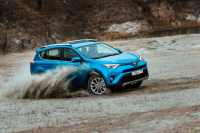 And now we come to the most important point of the crossover's handling - getting around obstacles. How passable are both cars? At first glance, the X-Trail has a clear advantage - ground clearance. It is 210mm versus 197mm for the competitor, and the front overhang is 910mm versus 940mm. A further comparison also shows the Nissan's lead, though not a significant one. Well-designed system of full drive control regulated by that very swivel washer mentioned in the interior helps to take the lead in this matter. But the weak link of this crossover is the variator, which overheats too much under serious loadings, and at low revolutions provides "digging" in loose snow. Toyota's appeal is the 6-speed automatic, which will pull you onto the hard surface more reliably and predictably.
And now we come to the most important point of the crossover's handling - getting around obstacles. How passable are both cars? At first glance, the X-Trail has a clear advantage - ground clearance. It is 210mm versus 197mm for the competitor, and the front overhang is 910mm versus 940mm. A further comparison also shows the Nissan's lead, though not a significant one. Well-designed system of full drive control regulated by that very swivel washer mentioned in the interior helps to take the lead in this matter. But the weak link of this crossover is the variator, which overheats too much under serious loadings, and at low revolutions provides "digging" in loose snow. Toyota's appeal is the 6-speed automatic, which will pull you onto the hard surface more reliably and predictably.
Cost
As of 2017, in showrooms the Nissan's price ranges from 19 600 dollars to 28 600 USD, depending on the engine and option package. And the Toyota's price starts at the 22 800 mark and ends at $33 800. There is a place to run wild. Remarkably, though the price of the Rav4 is higher, the company offers buyers a bigger choice of option packages. In addition, the brand is more popular on the old market and is in high demand, which also affects the price.
To sum up
It's hard to imagine more equal competitors than the Toyota Rav4 and Nissan X-Trail. They have no absolute disadvantages - what some would consider a disadvantage, others would call an advantage. They are very similar, but incredibly different. The former is the benchmark for a calm and confident ride, driving which will never make your blood pressure spike, while the other flirts with you at every turn, boosting your mood. But at the same time, they both handle all corners and obstacles perfectly, and have the same suspension stiffness. The Rav has a roomy boot, while the X-Trail has a more attractive interior. The Nissan has a lower cost, but the Toyota has a reputation. There is no winner in the contest that has been waged, as you can't compare a guitar and a violin to determine who is better. Each instrument plays individually beautifully, has advantages and has its own fans. So the choice is yours: Solid and poised or Attractive and mischievous.
